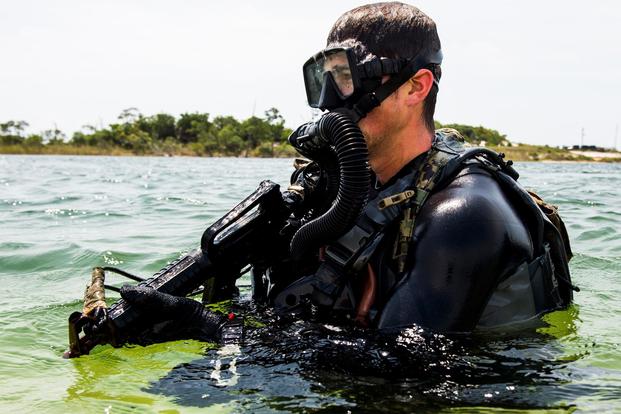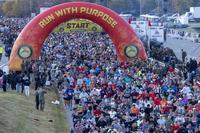Preparing for any special-ops training program while at sea can be difficult, especially when seas are rough, time is tight and you only can do calisthenics and use a few cardio machines for exercise.
Here is a question from a young man seeking to prepare for SEAL Officer Assessment and Selection (SOAS), a three-week officer selection program that is a major step in getting invited to come back to BUD/S as an officer within the next year.
Stew, I work at sea for about 50 days between port calls, so there are significant periods that I cannot swim and, depending on the seas, free weights on the boat can be dangerous. Any recommendations as I prepare for SOAS in the summer? I typically need the most work on swimming and rucking. We have a gym with free weights and cardio machines, and I have a TRX and about 2-2.5 hours to train (civilian ship). -- Thanks, Bob
Training underway is usually difficult due to lack of time. It looks like you are making time, so good job. You cannot swim while you are on a boat, but there are some dry-land training activities you can do with calisthenics/weights to work the muscles of swimming. You also will have to work on your cardio with the machines available.
Rucking
I would wear a weight vest throughout your workout and even for a few hours during the day, if possible, especially walking up/down stairs. Do it even if you're just standing in place to get used to the load bearing of rucking. If you can get on the treadmill for significant time during the workout, I would do that, especially if rucking is one of your weaknesses. Be sure to make logical progressions. Do not just jump on a two-hour ruck out of the blue.
The best goal to strive for while underway is to maintain your strengths and work on your weaknesses if you can. Make weakness training the main focus of the time you are on the ship.
That means PT with calisthenics if muscle stamina is an issue and work with weights if strength is an issue. Run, bike and elliptical more if cardio endurance is an issue. However, I would make sure you are getting in plenty of time doing Tabata Intervals, fast-pace running, biking, elliptical or rowing with increasing resistance to work the legs even more. See bike pyramid.
If rucking is your weakness, I would focus on treadmill work with a weight vest or backpack and add the weight vest to calisthenics on leg days. Mix in some deadlifts and hang cleans with a barbell or dumbbells to build a foundation of strength to help you manage load bearing better.
But the cardio with the weight is key. You need to build your running up, as it is difficult to progress in rucking if your running is not good. Read more.
Related: The Rules of Rucking
For your case specifically -- training for SEAL Officer Assessment and Selection -- you have to be focused on fairly high-intensity, long-duration training to prepare for an intense two-week period at SOAS. You should be preparing for long workdays, moving around with weight, quick extra PT/run sessions and calisthenics spread through the day (upper-body/lower-body day splits).
It sounds like your work schedule is ideal to prepare for training at SOAS. The added mix of calisthenics, weights, cardio and load bearing will help you add to that work capacity and durability. My advice is to get on a running plan and do 1-2 rucks per week on the longer run days instead of running.
Work on your rucking pace. Fast walk and shuffle. That speed range should be about a 10-minute mile and 14-minute mile (walking). The shuffle-run movement should keep you in the pack if you practice it enough.
Swimming
Swimming without water is difficult but can be done (kind of) with the following exercise options.
Think about the movements of swimming. You will be pulling with your arms from overhead (pull-ups). You will be pushing with your triceps to finish the arm stroke (dips). I would focus on PT pyramids/super sets and max rep sets to keep the push-up, pull-up, dip and sit-up numbers high throughout the week, but rest with flutter kicks. Read more.
Swimming with fins is hard on the hips and legs. Add weight to the legs when doing flutter kicks, leg levers, scissor exercises (wet pants, boots, etc.). That will help work the muscles of swimming. Also see the PT reset to work the upper-back and lower-back (core) muscles that are involved with swimming. Drop down throughout the day and do these.
Hope this helps. Let me know if you have more specific questions.
-- Stew
Stew Smith is a former Navy SEAL and fitness author certified as a Strength and Conditioning Specialist (CSCS) with the National Strength and Conditioning Association. Visit his Fitness eBook store if you’re looking to start a workout program to create a healthy lifestyle. Send your fitness questions to stew@stewsmith.com.
Want to Learn More About Military Life?
Whether you're thinking of joining the military, looking for fitness and basic training tips, or keeping up with military life and benefits, Military.com has you covered. Subscribe to Military.com to have military news, updates and resources delivered directly to your inbox.
















